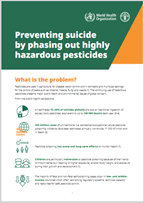Suicide prevention
More than 720 000 people die by suicide every year. For each suicide, there are an estimated 20 suicide attempts.
Suicide can occur at any stage of life and in all regions of the world. In 2021, suicide was the third leading cause of death among 15–29-year-olds globally, and 73% of all suicides happened in low- and middle-income countries. Almost 20% of global suicides were due to pesticide self-poisoning.
While the link between suicide and mental health conditions (in particular, depression and alcohol use disorders) and a previous suicide attempt is well established in high-income countries, many suicides happen impulsively in moments of crisis. Further risk factors for suicide include experience of loss, loneliness, discrimination, relationship dispute, financial problems, chronic pain and illness, violence, abuse, and conflict or other humanitarian emergencies.
Stigma around mental health conditions and suicide means many people thinking about suicide do not seek help. Suicides and suicide attempts have a ripple effect that impacts on families, friends, colleagues, communities and societies.
Much can be done at individual, community and national levels to prevent suicide and suicide attempts.
WHO’s LIVE LIFE approach recommends four effective, evidence-based key interventions which should be included in every national response to suicide:
- limit access to the means of suicide
- interact with the media for responsible reporting of suicide
- foster socio-emotional life skills in adolescents
- early identify, assess, manage and follow up anyone who is affected by suicidal behaviours.
The foundational pillars of the interventions are situation analysis, multisectoral collaboration, awareness raising, capacity building, financing, surveillance, monitoring and evaluation.
Suicide prevention efforts require coordination and collaboration among multiple sectors, including health, education, labour, agriculture, business, justice, law, defence, politics and the media. Suicide prevention is often not adequately addressed because of stigma and lack of awareness that suicide is a major public health problem.
Communities also play a crucial role in preventing suicide. The WHO community engagement toolkit guides communities in identifying priorities and implementing activities according to local contexts.
The urgency to act to prevent suicides has been recognized and prioritized at the highest levels.
The reduction of suicide rates in countries is an indicator in the UN Sustainable Development Goals (the only indicator for mental health), WHO’s General Programme of Work and WHO’s Comprehensive Mental Health Action Plan 2013–2030.
The first WHO world suicide report, Preventing suicide: a global imperative, published in 2014, aimed to increase awareness of the public health significance of suicide and suicide attempts and make suicide prevention a public health priority.
Governments are encouraged to join WHO’s LIVE LIFE initiative, implement WHO’s LIVE LIFE package of effective and evidence-based key interventions for suicide prevention, and develop or strengthen comprehensive national suicide prevention strategies in a multisectoral public health approach. National leadership and coordination on suicide prevention are further supported by the publication of National suicide prevention strategies: progress, examples and indicators.
Recognizing that data and statistics are necessary for advocacy and decision-making, WHO published Suicide worldwide in 2021: global health estimates.
WHO’s vision is a world where death by suicide is no longer a leading cause of death and where people who are attempting or thinking about suicide feel comfortable seeking help which is provided capably and respectfully to all.




